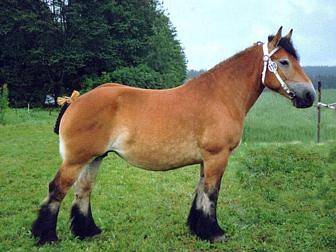
OVERVIEW
The purpose for creating the Swedish Ardennes was to develop a heavier horse than the native Swedish horses. Farming's popularity grew in Sweden in the late 1800s requiring horses to do heavier work than the native country horse could handle. Although modern mechanization has, for the most part, made farm work for the horse irrelevant, it is still popular as a cart horse.
PHYSICAL DESCRIPTION
Standing around 15 to 16 hands high, the Swedish Ardennes is a medium build heavy draft breed. Although not exactly distinguished, the horse more than makes up for this lack through its good health, longevity and sweet temper. Its head is heavy with a smallish eye. The neck is short and thick. The back short, the chest wide, and the shoulders are well muscled.
ORIGIN
In an effort to create heavier horses in Sweden, the Count C.G. Wrangle brought the large Ardennes horse to the country in 1872. By 1880 most parts of south and central Sweden had imported or crossed Ardennes. These heavier horses were bred with the horse of the Swedish countryside. The resulting horse was very mobile and marked by longevity. So successful was the breeding effort that a stud book was opened in 1901.
INTERESTING FACTS
For years, the wild horse population of Sweden was indiscriminately crossed with other imported breeds. Even when studs began focusing their breeding efforts, however, horses were chosen more for their outer looks than well examined conformation standards. By 1874, this had all changed and examinations were required for a horse of Swedish Warmblood, Swedish Ardennes, and North Swedish Horse stock to be entered into a stud book.
INFLUENCES
1. Forest Horse
2. Ardennes
3. Swedish Country Horse
For more information:
Avelsforeningen For Svenska Ardennerhasten
571 61 Bodafors
SWEDEN
Phone & Fax: 0380-308 61